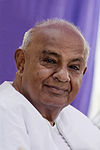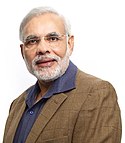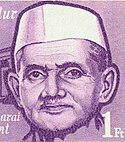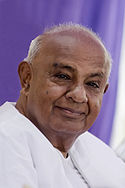Premierzy Indii
| IndieTen artykuł jest częścią serii: Ustrój i polityka Indii Ustrój polityczny Konstytucja Władza ustawodawcza Władza wykonawcza Władza sądownicza Kontrola państwowa Finanse Samorząd terytorialny Partie polityczne Wybory Polityka zagraniczna Wikiprojekt Polityka |
Chronologiczna lista premierów Indii:
| Lp. | Portret | Polityk (lata życia); okręg wyborczy | Okres rządów[1] | Elekcja | Desygnujący | Partia polityczna (sojusz) | ||||
|---|---|---|---|---|---|---|---|---|---|---|
| 1 | Jawaharlal Nehru (1889–1964) Phulpur | 1 | 15 sierpnia 1947 | 27 maja 1964 | 16 lat 286 dni | – | Lord Mountbatten | Indyjski Kongres Narodowy | ||
| 2 | 1951 - 1952 | Rajendra Prasad | ||||||||
| 3 | 1957 | |||||||||
| 4 | 1962 | |||||||||
| 2 | Gulzarilal Nanda (1898–1998) Sabarkantha | [4] | 27 maja 1964 | 9 czerwca 1964 | 13 dni | – | Sarvepalli Radhakrishnan | |||
| 3 |  | Lal Bahadur Shastri (1904–1966) Allahabad | 5 | 9 czerwca 1964 | 11 stycznia 1966 | 1 rok 216 dni | – | |||
| (2) | Gulzarilal Nanda (1898–1998) Sabarkantha | [5] | 11 stycznia 1966 | 24 stycznia 1966 | 13 dni | – | ||||
| 4 |  | Indira Gandhi (1917–1984) Rae Bareli | 6 | 24 stycznia 1966 | 24 marca 1977 | 11 lat 59 dni | – | |||
| 7 | 1967 | |||||||||
| 8 | 1971 | Varahagiri Venkata Giri | ||||||||
| 5 |  | Morarji Desai (1896–1995) Surat | 9 | 24 marca 1977 | 28 lipca 1979 | 2 lata 126 dni | 1977 | Basappa Danappa Jatti | Janata | |
| 6 | Choudhary Charan Singh (1902–1987) Baghpat | 10 | 28 lipca 1979 | 14 stycznia 1980 | 170 dni | – | Neelam Sanjiva Reddy | Janata Party (Secular) w koalicji z Indyjskim Kongresem Narodowym | ||
| (4) |  | Indira Gandhi (1917–1984) Rae Bareli | 11 | 14 stycznia 1980 | 31 października 1984 | 4 lata 291 dni | 1980 | Indyjski Kongres Narodowy | ||
| 7 |  | Rajiv Gandhi (1944–1991) Amethi | [11] | 31 października 1984 | 2 grudnia 1989 | 5 lat 32 dni | – | Giani Zail Singh | Indyjski Kongres Narodowy | |
| 12 | 1984 | |||||||||
| 8 |  | Vishwanath Pratap Singh (1931–2008) Fatehpur | 13 | 2 grudnia 1989 | 10 listopada 1990 | 343 dni | 1989 | Ramaswamy Venkataraman | Janata Dal (Front Narodowy) | |
| 9 | Chandra Shekhar (1927–2007) Ballia | 14 | 10 listopada 1990 | 21 czerwca 1991 | 223 dni | – | Samajwadi Janata Party w koalicji z Indyjskim Kongresem Narodowym | |||
| 10 |  | P.V. Narasimha Rao (1921–2004) Nandyal | 15 | 21 czerwca 1991 | 16 maja 1996 | 4 lata 330 dni | 1991 | Indyjski Kongres Narodowy | ||
| 11 |  | Atal Bihari Vajpayee (1924–2018) Lucknow | 16 | 16 maja 1996 | 1 czerwca 1996 | 16 dni | 1996 | Shankar Dayal Sharma | Indyjska Partia Ludowa | |
| 12 |  | Deve Gowda (ur. 1933) Karnataka | 17 | 1 czerwca 1996 | 21 kwietnia 1997 | 324 dni | – | Janata Dal | ||
| 13 |  | Inder Kumar Gujral (1919–2012) Bihar | 18 | 21 kwietnia 1997 | 19 marca 1998 | 332 dni | – | |||
| (11) |  | Atal Bihari Vajpayee (1924–2018) Lucknow | 19 | 19 marca 1998 | 22 maja 2004 | 6 lat 64 dni | 1998 | Kocheril Raman Narayanan | Indyjska Partia Ludowa | |
| 20 | 1999 | |||||||||
| 14 |  | Manmohan Singh (ur. 1932) Assam | 21 | 22 maja 2004 | 26 maja 2014 | 10 lat 4 dni | 2004 | A.P.J. Abdul Kalam | Indyjski Kongres Narodowy | |
| 22 | 2009 | Pratibha Patil | ||||||||
| 15 |  | Narendra Modi (ur. 1950) Vadodara i Varanasi | 23 | 26 maja 2014 | Urzęduje | - | 2014 | Pranab Mukherjee | Indyjska Partia Ludowa | |
Przypisy
Bibliografia
Media użyte na tej stronie
The Flag of India. The colours are saffron, white and green. The navy blue wheel in the center of the flag has a diameter approximately the width of the white band and is called Ashoka's Dharma Chakra, with 24 spokes (after Ashoka, the Great). Each spoke depicts one hour of the day, portraying the prevalence of righteousness all 24 hours of it.
Prime Minister Narasimha Rao addressing a joint session of US congress
Autor: World Economic Forum, Licencja: CC BY-SA 2.0
Prime Minister Manmohan Singh in the Opening Plenary - Resillient india: 25 years of Economic and Social Progress. Participants captured during the World Economic Forum's India Economic Summit 2009 held in New Delhi, 8-10 November 2009.
Autor: Flickr: Narendra Modi, Licencja: CC BY 2.0
Narendra Modi, Prime Minister of India
The National Emblem of India is derived from the time of the Emperor Ashoka. The emblem is a replica of the Lion of Sarnath, near Varanasi in Uttar Pradesh. The Lion Capital was erected in the third century BC by Emperor Ashoka to mark the spot where Buddha first proclaimed his gospel of peace and emancipation to the four quarters of the universe. The national emblem is thus symbolic of contemporary India’s reaffirmation of its ancient commitment to world peace and goodwill. The four lions(one hidden from view ) – symbolising power, courage and confidence- rest on a circular abacus. The abacus is girded by four smaller animals—Guardians of the four directions: The Lion of the North, The Horse of the West, The Bull of the South and The Elephant of the East. The abacus rests on a lotus in full bloom, exemplifying the fountainhead of life and creative inspiration. The motto 'Satyameva Jayate' inscribed below the emblem in Devanagari script means 'truth alone triumphs'.
Lal Bahadur Shastri, the 2nd Prime minister of India.
Image cropped from the original using GIMP 2.6.10.
(c) Bundesarchiv, Bild 183-61849-0001 / CC-BY-SA
Dla celów dokumentacyjnych Niemieckie Archiwum Federalne często zachowywało oryginalny opis fotografii, który może być błędny, tendencyjny, przestarzały bądź politycznie skrajny. Korekty i alternatywne opisy są wpisane oddzielnie od opisu oryginalnego. Dodatkowe błędy można zgłaszać na tej stronie w celu poinformowania Niemieckiego Archiwum Federalnego.
Oryginalny opis Archiwum:
Indien, Otto Grotewohl bei Ministerpräsident Nehru Zentralbild/Heilig 27.1.59 Ministerpräsident Grotewohl bei Ministerpräs bcggffd grdetsfgsdeident Nehru Ministerpräsident Otto Grotewohl und der indische Ministerpräsident Nehru trafen am 12.1.59 zu einer Unterredung zusammen. Das Gespräch währte drei Stunden und verlief sehr herzlich. UBz.: Ministerpräsident Nehru (links) im freundschaftlichen Gespräch mit Ministerpräsident Otto Grotewohl (links im Hintergrund) der Stellvertreter des Vorsitzenden des Ministerrates und Minister für Auswärtige Angelegenheiten, Dr. Lothar Bohlz. Abgebildete Personen: * Grotewohl, Otto: Ministerpräsident, stellvertretender Staatsratsvorsitzender, DDR * Nehru, Jawaharlal Pandit: Premierminister, Präsident der Kongresspartei, Indien
Autor: Bart Molendijk / Anefo, Licencja: CC BY-SA 3.0 nl
Rajiv Gandhi, Former Prime Minister of India
Autor: Biswarup Ganguly, Licencja: CC BY-SA 3.0
Inder Kumar Gujral (born 4 December 1919) served as the 13th Prime Minister of the Republic of India. This photograph was taken at Science City, Kolkata on traditional 35 mm film; the negative was scanned by Nikon scanner after 10 years. It is a cropped image.
Library of Congress. specified as PD, from release.
















